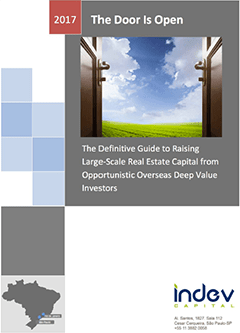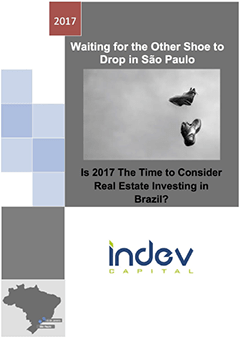Bank Repossession
Due to significant inventory levels and some developers not being able to pay down their project-level and/or holding company debt, the real estate assets the banks “took back” more than doubled in the last two years and reached almost R$10 billion in 2017 (source: Valor Econômico). Banks are not set up to manage this inventory and will try to sell this inventory when the market recovers. Investors focused on the São Paulo market need to be aware of this reality, however, for the reasons listed below, this is not as pertinent for the São Paulo market.
-
R$10 billion in real estate assets have been taken back among major Brazilian banks (Itaú, Bradesco, Santander, Banco do Brasil and Caixa Econômica Federal) according to estimates by Valor Econômico, out of which 50% (R$5B) is estimated to be residential. The other 50% of the assets repossessed are commercial buildings, industry and logistic warehouses, land plots, farms, beach houses, etc., taken as collateral for corporate loans in general.
-
The total residential inventory in Brazil – in the hands of developers – is estimated at R$100 billion, so bank-repossessed assets would increase the total volume by only 5%.
-
The large majority of the bank-repossessed inventory is outside of the metropolitan region of São Paulo. In particular, large numbers of units were given back to banks in cities such as Salvador (2,028 km from São Paulo), Curitiba (418 km from São Paulo), Manaus (3,922 km from São Paulo), and other cities and state capitals throughout Brazil. In addition, most of these can be considered “dead inventory”, belonging to projects with low adherence to the market demand.
-
When the market reached the top of its expansion, there was high liquidity both in credit, equity (IPO proceeds), and pre-sales. This momentum encouraged developers to acquire significant quantities of land and launch units all over Brazil as part of a plan to expand operation nationwide. Developers launched projects in other states and cities in Brazil as part of an expansion plan and didn’t execute a deep analysis of the areas and target locations before starting projects.
-
Banks financed developers at the company and the project level without concern about the developers’ expertise in a given market and without sufficient market analysis. Banks, not too different from developers, desired to profit from the expansion and this meant providing ample credit. When the market corrected in 2014, developers immediately started to have problems of low sales and cancellations. As a result, developers couldn’t pay banks back and banks started to execute guarantees and take back the units.
Distratos – Sales Cancellations
During the worst part of the cycle in 2015-2016, some projects had as high as 75% of the units that had signed contracts to purchase canceled. How did the number get so high?
-
Low Down Payments – This left the buyer with nothing to lose. In fact, at times the down payment was so low, 5%, particularly for units bought at launch, that it was almost as if the buyer were simply purchasing an option to purchase.
-
Small Investor – Many developers sold to smaller retail investors. This investor’s goal was to “tie up” multiple high-quality apartments at launch and then sell before the end of construction to a buyer who would complete the purchase with a down payment and a mortgage or cash. When there was no longer price appreciation, and in some situations even depreciation, these small investor buyers ran for the exits as many never intended to actually own the property nor had the capacity to actually purchase the unit.
-
Price Adjustment – Many developers tried to maximize sales price, perhaps too much, in their launches. As the market slowed, although they had already sold units of a given price and those buyers were still paying, developers lowered the price to keep sales moving. Many early buyers felt cheated and decided it was better to cancel than overpay in comparison to those who purchased later. A vicious cycle was created.
.




